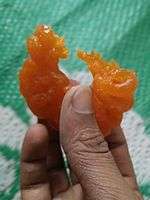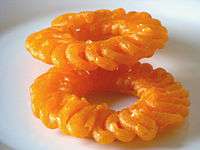Imarti
|
Imarti | |
| Alternative names | Emarti, Jaangiri, Omriti |
|---|---|
| Course | Dessert |
| Place of origin | India |
| Main ingredients | Urad flour, saffron, ghee, sugar |
|
| |
Imarti or Jhangri is a dessert introduced by Mughal cooks to India and other countries of the Indian Subcontinent. It is made by deep-frying urad flour batter in a kind of circular flower shape, then soaked in sugar syrup. Alternative names include Amriti, Emarti, Omriti and Jaangiri. This dish is not to be confused with Jalebi which has comparatively thinner material and is sweeter than Imarti.
Ingredients
Imarti is made from a variety of urad flour, also colloquially called jalebi parappu (dal) or jalebi urad in south India. Sugar syrup and saffron is added for colour.
Preparation

Urad dal is soaked in water for few hours, and stone-ground into a fine batter. The batter is poured into ghee, though other oils are sometimes used. Similarly to funnel cakes, the batter is poured into geometric patterns, although imartis are generally smaller than funnel cakes. There is often a small ring in the middle.
Before frying the batter, sugar syrup is prepared and is usually flavored with edible camphor, cloves, cardamom and saffron. The fried material is then dipped in sugar syrup until it expands in size and soaks up a significant amount of the syrup. In Northern India imartis are usually drained, so tend to be drier than jalebis. The pieces can be served hot, at room temperature, or sometimes refrigerated.
- Frying process
 After frying
After frying
Serving
In South India, this sweet is served during the meal and also popular at weddings and festivals. In particular, Jaunpur in Uttar Pradesh is famous for its imarti.[1]
 Ready to serve in a street stand
Ready to serve in a street stand Imarti served in streets of Delhi
Imarti served in streets of Delhi Imarti
Imarti
See also
References
- ↑ Keshavrao, Dhanvanti (6 July 2013). "A sweet tale of an exotic dessert". Retrieved 27 May 2015.
External links
 Media related to Imarti at Wikimedia Commons
Media related to Imarti at Wikimedia Commons
